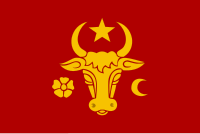Coat of arms of Moldavia
 |
|
| Name | Romanian: Cap de bour |
|---|---|
| Use |
State and war flag |
| Proportion | 2:3 (?) |
| Design | Possible version of a Moldavian princely standard during Stephen the Great (attested versions of the number and general aspects of symbols other than the aurochs/wisent vary considerably) |
| Coat of arms of Moldavia | |
|---|---|
 |
|
| Details | |
| Armiger | The Domn of Moldavia |
| Escutcheon | Gules, aurochs sable/or, rose, and crescent argent/or, five pointed star or |
The flag and coat of arms of Moldavia, one of the two Danubian Principalities, together with Wallachia, which formed the basis for the Romanian state, were subject to numerous changes throughout their history.
A princely standard was first attested under the rule of Prince Stephen the Great (late 15th century), depicting an or aurochs/wisent head (most likely alluding to the legends surrounding Moldavia's foundation by Dragoș), flanked by stylised figures of the Sun and crescent Moon (or other symbols, such as the rosette and star) set against a gules (or possibly purpure) background; its obverse displayed the figure of Saint George slaying the Dragon. The depiction of the Battle of Baia (1476) in Johannes de Thurocz's Chronicle shows Moldavian troops carrying a pennant with the aurochs head on pales of unspecified colour. In 1574, Moldavian delegates to the coronation of Henry III of Poland are attested to have carried a blue banner with the auroch's head.
Moldavia's fall under Ottoman Empire control, a process which was accelerated during the 16th century, saw a decline in flag usage; as princes became appointees of the Sultans, the usage of a sanjak as a mark of authority became widespread.
...
Wikipedia
